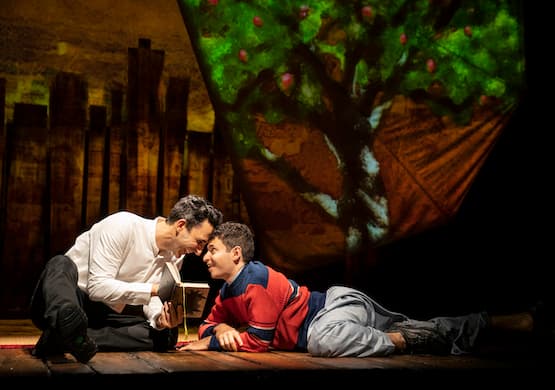Like a Summer Day, ‘The Kite Runner’ Is Pleasant and Long
Matthew Spangler’s adaptation of Khaled Hosseini’s best-selling novel offers more length than depth.

At least playwright Matthew Spangler didn’t try to turn “The Kite Runner” into a musical.
Khaled Hosseini’s best-selling debut novel, an earnest but evocative account of an Afghan immigrant’s journey from a privileged childhood in Kabul through political strife to asylum and adulthood in California — a story that mirrors Mr. Hosseini’s own in these basic details, if not in other specifics — is just the sort of sprawling, culturally relevant, but simplistic account of conflict and growth that makes producers of commercial theater and film drool. (A screen adaptation was released in 2007, four years after the book was published.)
In his program notes for the Broadway production of “The Kite Runner” — which follows stagings on the West End and in Dubai, as well as a U.K. tour — Mr. Spangler writes, “This is a story about a father and son; two best friends; a husband and wife; immigration; the relative peace of 1970s Afghanistan; global politics; class and ethnicity; and much more. Above all, ‘The Kite Runner’ is a story of guilt and redemption.”
Of course, many such elements turn up regularly in the most insipid television movies, and while Mr. Spangler’s play doesn’t suggest that low a bar, it offers, at roughly two and a half hours, more length than depth.
The central relationship is between Amir, the intelligent but lonely son of an affluent Pashtun, and Hassan, introduced as the child of Amir’s father’s servant, who belongs to a historically persecuted ethnic group, the Hazaras. Further separated by their religious branches — Pashtuns are Sunni Muslims, Amir explains, while Hazaras are Shia — the boys are nonetheless raised side by side from infancy, after Amir’s mother dies in childbirth and Hassan’s leaves her husband, for reasons that initially seem suspicious but make more sense after a late plot twist.
Amir, played as a tween and an adult by a star of “The Blacklist,” Amir Arison, nonetheless seems ambivalent about calling Hassan a friend, despite the latter’s fierce loyalty to him. It is Amir’s betrayal of that devotion, in a devastating incident stemming from the boys’ participation in a kite-flying competition — Hassan is the runner, his mastery at retrieving objects making him seem, sadly, even more like a faithful dog — that finally breaks their bond, and ends up haunting Amir into adulthood.
This is the guilt to which Mr. Spangler refers, and it’s no doubt enhanced by Hassan’s preternatural selflessness. Although brought to piercing life in a radiant performance by Eric Sirakian, the servant’s son suggests more a symbol of oppression and sacrifice than an actual human being. Other characters seem similarly two-dimensional and contrived, from Assef (Amir Malaklou), the neighborhood bully who torments both boys, to Hassan’s obedient but dignified father, Ali (Evan Zes, who like Mr. Sirakian pops up in another role in Act Two).
Amir’s dad, referred to simply as Baba — Persian for father — evolves more, but in a clichéd fashion, starting off as a rigid taskmaster disappointed by his gentle, creative son but gradually revealing affection and even pride; Faran Tahir brings pluck and pathos to the part. Azita Ghanizada proves equally game, and elegant, in the one female role that is substantial, at least in terms of size: that of Soraya, the demure but independent-minded Afghan immigrant who catches the college-aged Amir’s eye, and becomes his perfect wife.
As the protagonist and narrator, Amir is given slightly more range, but Mr. Arison and director Giles Croft tend to overpitch, so that moments of emotional pique often seem melodramatic, as if Mr. Croft didn’t trust the audience to pick up on relative nuances. In its presentation, in fact, “Kite Runner” can have the feel of an expertly produced children’s fable, from the tabla artist (Salar Nader) who sits onstage and embellishes the action with his simple drumming, to Barney George’s spare but lovely scenic design, which with Charles Balfour’s lighting presents twinkling vistas of San Francisco and Kabul.
There is charm, and comfort, to be found in these and other features of “The Kite Runner.” Still, you’ll likely leave the theater wishing that the individual and collective struggles at play here, which are both topical and timeless, were more fully explored.

